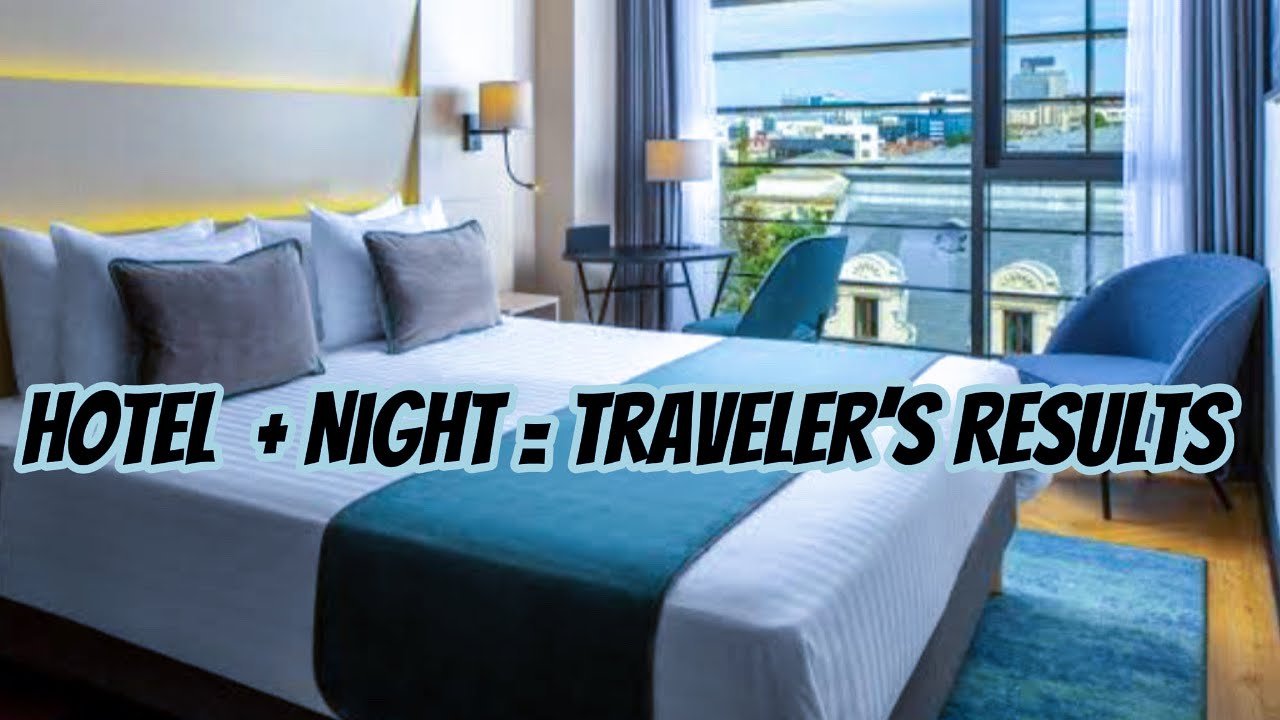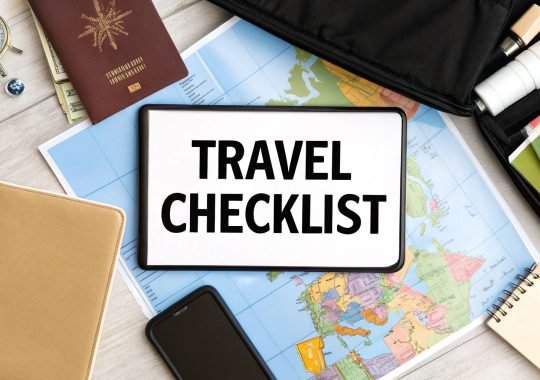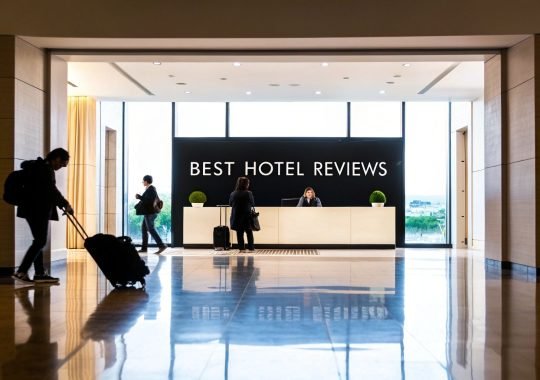Traveling offers a chance to explore and relax, but ensuring your safety is paramount for a truly enjoyable experience. From the moment you book your room to the day you check out, being proactive about security can make all the difference. While hotels implement various safety measures, the most prepared traveler is always the safest one. This comprehensive guide moves beyond generic advice to provide you with actionable, in-depth hotel safety tips that empower you to take control of your well-being.
We’ll cover everything from conducting pre-arrival research and strategically selecting your room to performing thorough room inspections and safeguarding your digital information. This listicle is designed to be your go-to resource, detailing the specific actions you can take to mitigate risks and handle unexpected situations with confidence. We believe a well-informed traveler is a confident one, and a secure stay is a happy one. These essential strategies will help you maintain peace of mind on your next adventure, ensuring you can focus on making memories, not worrying about what could go wrong. Let’s dive into the practical steps that guarantee a secure and worry-free hotel stay from check-in to check-out.
1. Research Your Hotel and Area Before Arrival
Your safety during a hotel stay begins long before you swipe a key card. Conducting thorough due diligence on your chosen hotel and its surrounding neighborhood is the single most proactive step you can take. This foundational research sets the stage for a secure trip by helping you anticipate potential risks and select accommodations that prioritize guest well-being.
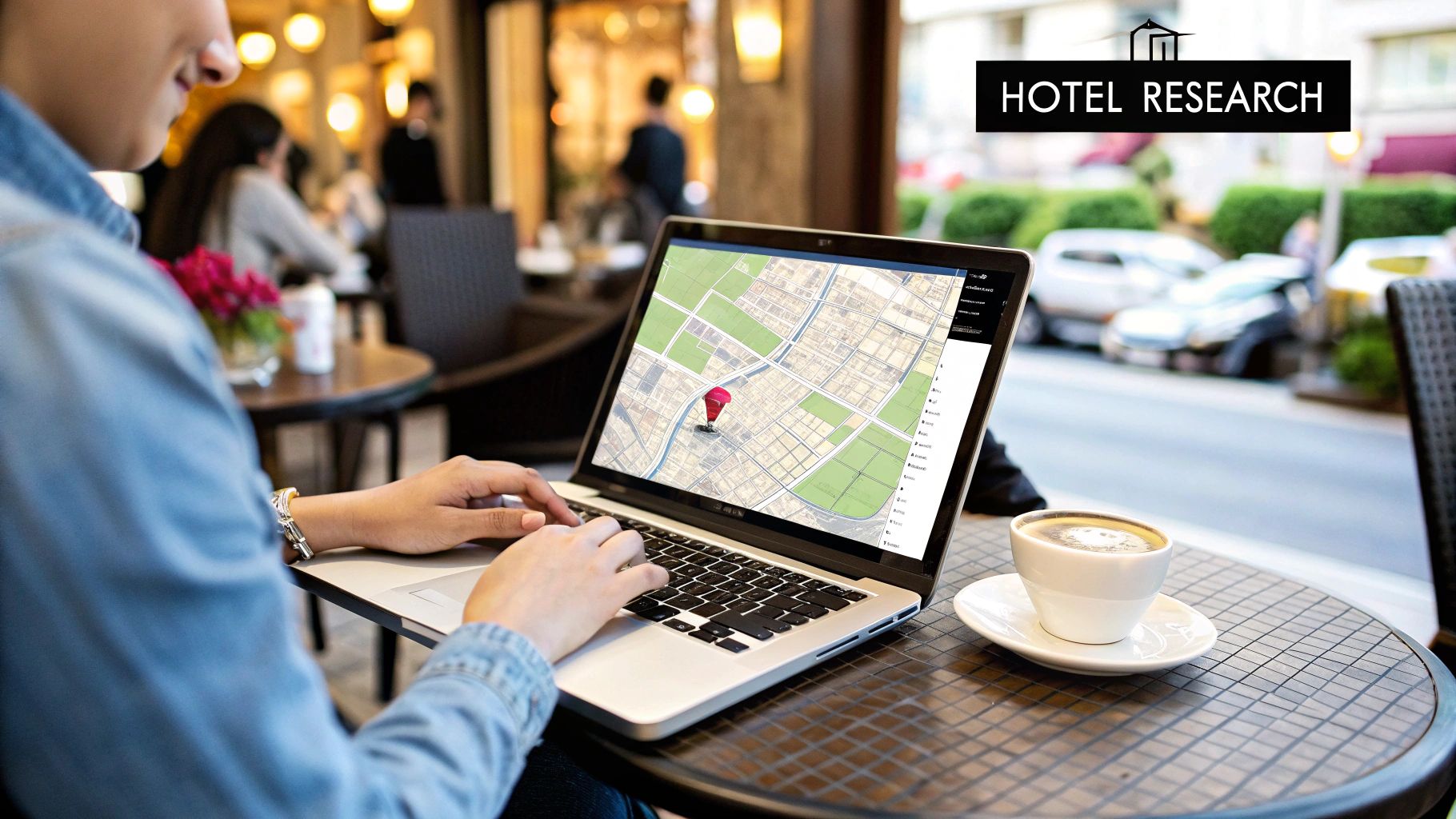
This process involves more than just glancing at star ratings. It’s about becoming an informed consumer, actively seeking out specific details that contribute to a safer environment. Think of it as creating your own personal security briefing before you even pack your bags.
How to Conduct Your Pre-Trip Investigation
Effective research combines insights from official sources, peer reviews, and direct observation of the hotel’s digital presence. Your goal is to build a complete picture of both the property itself and its immediate environment.
- Review Recent Guest Feedback: Scour platforms like Google Reviews and TripAdvisor. Use search terms within the reviews like “safety,” “security,” “door lock,” or “neighborhood” to filter for relevant comments. Pay closest attention to reviews posted within the last six months, as they reflect the most current conditions.
- Analyze the Neighborhood: Utilize online tools like Google Maps Street View to virtually “walk” around the hotel. Check for well-lit streets, the presence of other businesses, and the general upkeep of the area. For more in-depth data, look for local police department crime maps, which can highlight incident hotspots.
- Verify Hotel Security Features: A hotel’s official website often lists its security amenities. Look for mentions of 24/7 front desk staff, key card access to elevators and main entrances, in-room safes, and on-site security personnel.
Key Insight: A lack of recent reviews or an absence of security information on a hotel’s website can be as telling as negative feedback. Trust your instincts; if information is hard to find, it may be for a reason.
This pre-arrival diligence is one of the most crucial hotel safety tips because it empowers you to make an informed choice, avoiding potentially unsafe situations altogether. For a deeper dive into vetting properties, you can explore detailed guides on the best hotel rating websites to use for your research.
2. Choose Your Room Location Strategically
The specific location of your room within a hotel can dramatically impact your personal security and ability to evacuate in an emergency. Selecting your room strategically is not about getting the best view; it’s about balancing ease of exit with protection from external threats. A thoughtfully chosen room minimizes your visibility to potential criminals and maximizes your chances of a swift, safe escape if needed.
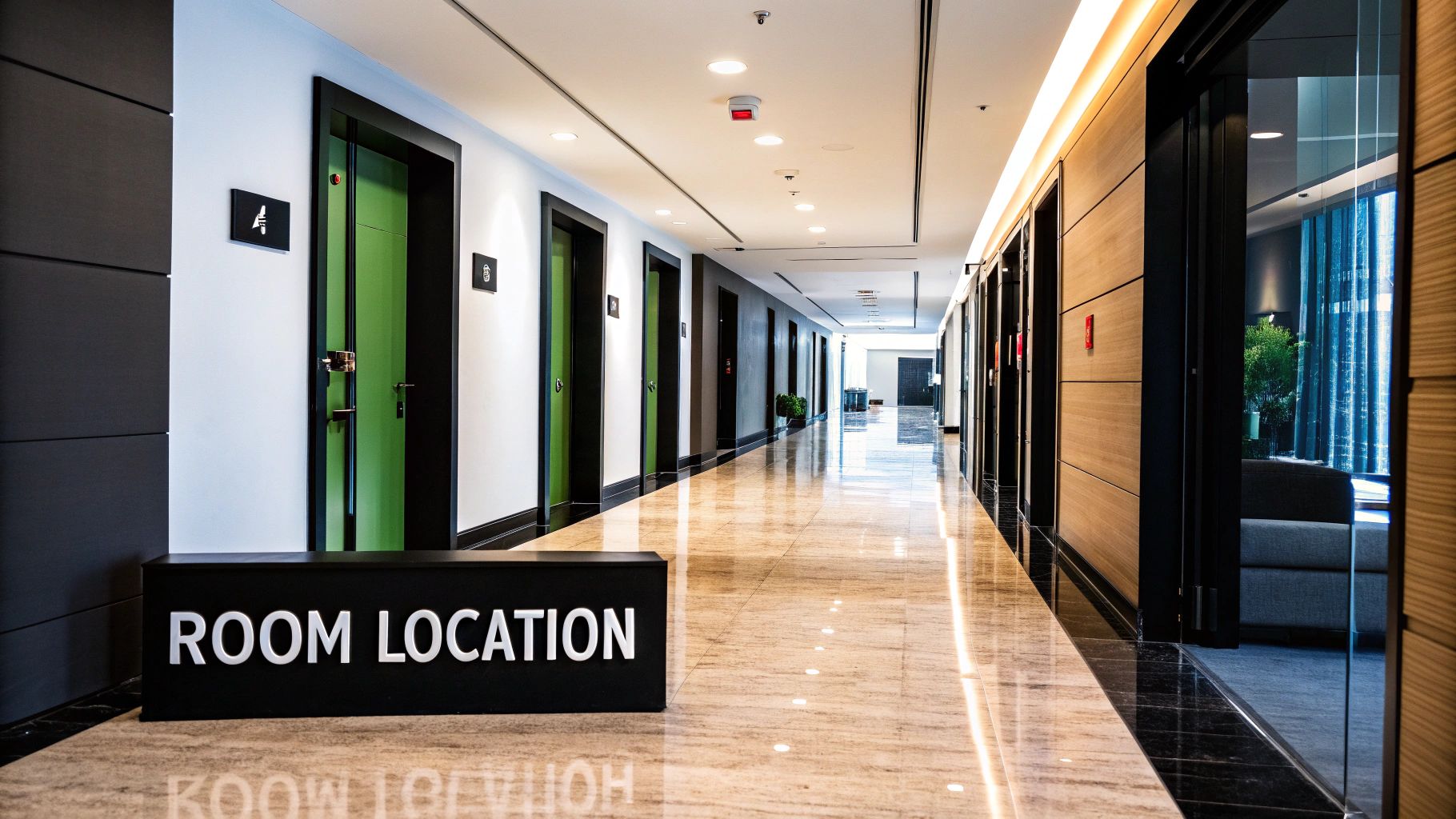
This aspect of hotel safety involves considering factors like the floor level, proximity to exits and elevators, and whether the room faces an internal corridor or an external walkway. By understanding the strategic advantages and disadvantages of different locations, you can make a request during booking that significantly enhances your safety.
How to Select a Secure Room Location
Your ideal room placement is a compromise between competing safety priorities. The goal is to avoid being an easy target while ensuring you are not trapped during a critical incident like a fire.
- Request an Optimal Floor: Aim for a room between the second and sixth floors. This range is high enough to deter ground-level break-ins but is typically within reach of fire department ladders. Ground floor rooms, while convenient, are the most vulnerable to intruders.
- Assess Proximity to Exits and Common Areas: Choose a room near a stairwell or emergency exit, but not directly next to it. Proximity allows for a quick escape, while being slightly removed reduces noise and foot traffic from people using the stairs. Similarly, avoid rooms right next to elevators, ice machines, or vending areas, as these high-traffic spots can attract unwanted attention.
- Prioritize Interior Corridors: Whenever possible, especially in motel-style properties, request a room with an entrance in an interior hallway. Rooms with doors that open directly to the outside (e.g., a parking lot) offer significantly less security and make you a more visible target.
Key Insight: Don’t hesitate to voice your preferences. When booking or checking in, politely request a room that meets your safety criteria. A simple statement like, “I’d prefer a room on the third or fourth floor, away from the elevator if possible,” is a reasonable and common request that hotels can often accommodate.
Strategically choosing your room is one of the most effective hotel safety tips because it puts physical barriers and tactical advantages between you and potential threats from the moment you check in. For more guidance on what to do once inside, you can review a comprehensive hotel room safety checklist to secure your immediate environment.
3. Inspect Your Room Thoroughly Upon Arrival
Once you’ve checked in and arrived at your door, the next critical phase of ensuring your safety begins. A systematic inspection of your hotel room is not about paranoia; it’s about being proactive and confirming that your temporary home is as secure as possible. This immediate check allows you to identify security flaws, safety hazards, or malfunctioning equipment before you settle in.
This process should be the first thing you do, even before unpacking. It involves a deliberate check of all security features, safety devices, and the general condition of the room. Think of it as a final verification step that confirms the hotel’s commitment to guest safety extends to your specific room.
How to Conduct a Systematic Room Inspection
Your room check should be a quick yet thorough routine. By focusing on key vulnerability points and safety equipment, you can efficiently assess your environment and address any issues with hotel management immediately.
- Test All Locks and Security Devices: Before bringing your luggage inside, prop the door open and test the primary lock, deadbolt, and any secondary security latches or chains. Ensure they engage fully and are sturdy. Also, check that balcony doors and any adjoining room doors lock securely from your side.
- Verify Safety Equipment: Locate the smoke detector and carbon monoxide detector. They should have a solid or slowly blinking light, indicating they are active. Check the room’s phone to confirm it has a dial tone so you can reach the front desk or emergency services if needed.
- Scan for Unusual Items: Take a moment to scan the room for anything out of place. Look for small holes in walls or objects, or unusual devices like USB chargers or alarm clocks that could potentially hide a camera. Check behind mirrors, in smoke detectors, and around outlets.
Key Insight: Never hesitate to request a new room if you find any security feature to be broken or malfunctioning. Your peace of mind is paramount, and a reputable hotel will accommodate a reasonable request for a more secure room.
This initial sweep provides both security and confidence for your stay. For a more comprehensive guide on preparing your room, you can learn more about tips on how hotel guests can sanitize their hotel room, which complements these safety checks.
4. Secure Your Valuables and Personal Information
Your physical safety is paramount, but protecting your valuables and personal information is a close second. A lost passport, stolen credit card, or compromised laptop can derail a trip and cause long-term headaches. Employing a multi-layered security strategy for your belongings is a critical hotel safety tip that safeguards you against both opportunistic theft and sophisticated digital threats.
This approach means not relying on a single method. It involves a combination of using hotel-provided security features, employing your own clever tactics, and maintaining strong digital hygiene. Think of it as creating concentric circles of protection around your most important assets.
How to Implement a Multi-Layered Security Strategy
A comprehensive plan protects your physical items and digital identity. This means securing what you leave in the room and what you carry with you, ensuring you have backups in case the primary measures fail.
- Utilize the In-Room Safe Correctly: The hotel safe is your first line of defense for items like passports, backup credit cards, extra cash, and small electronics. Always set your own unique code. Before using it, check that it’s securely bolted to the furniture or wall.
- Create Redundancy and Backups: Never keep all your valuables in one place. Store a backup credit card and some emergency cash in a separate location from your primary wallet, perhaps in a hidden pocket of your luggage. Digitize important documents like your passport, visa, and driver’s license, and store them securely in a password-protected cloud service.
- Protect Your Digital Footprint: Your digital information is as valuable as your physical possessions. Use an RFID-blocking wallet or sleeve to prevent skimmers from stealing credit card information. Be cautious when using hotel Wi-Fi; a VPN (Virtual Private Network) is essential for encrypting your internet traffic. Beyond physical precautions, it’s vital to safeguard your online accounts by implementing two-factor authentication.
- Practice “Out of Sight, Out of Mind”: Never leave valuables like laptops, cameras, or jewelry visible in your room, even for a few minutes. If an item is too large for the safe, secure it inside your locked luggage. For extra security, you can use a portable cable lock to attach your luggage to a heavy piece of furniture.
Key Insight: Assume that hotel safes are not infallible. While they deter most casual theft, they can sometimes be opened by staff. For irreplaceable items like expensive jewelry, consider using the hotel’s main safety deposit box at the front desk, which typically offers a higher level of security.
5. Practice Smart Key Card and Access Management
Your hotel key card is more than just a piece of plastic; it is the primary control for who enters your private space. Treating it with the same care you would your house keys is fundamental to your security. Proper management of key cards and vigilant control over who you allow through your door are critical hotel safety tips that prevent unauthorized access and protect your belongings.
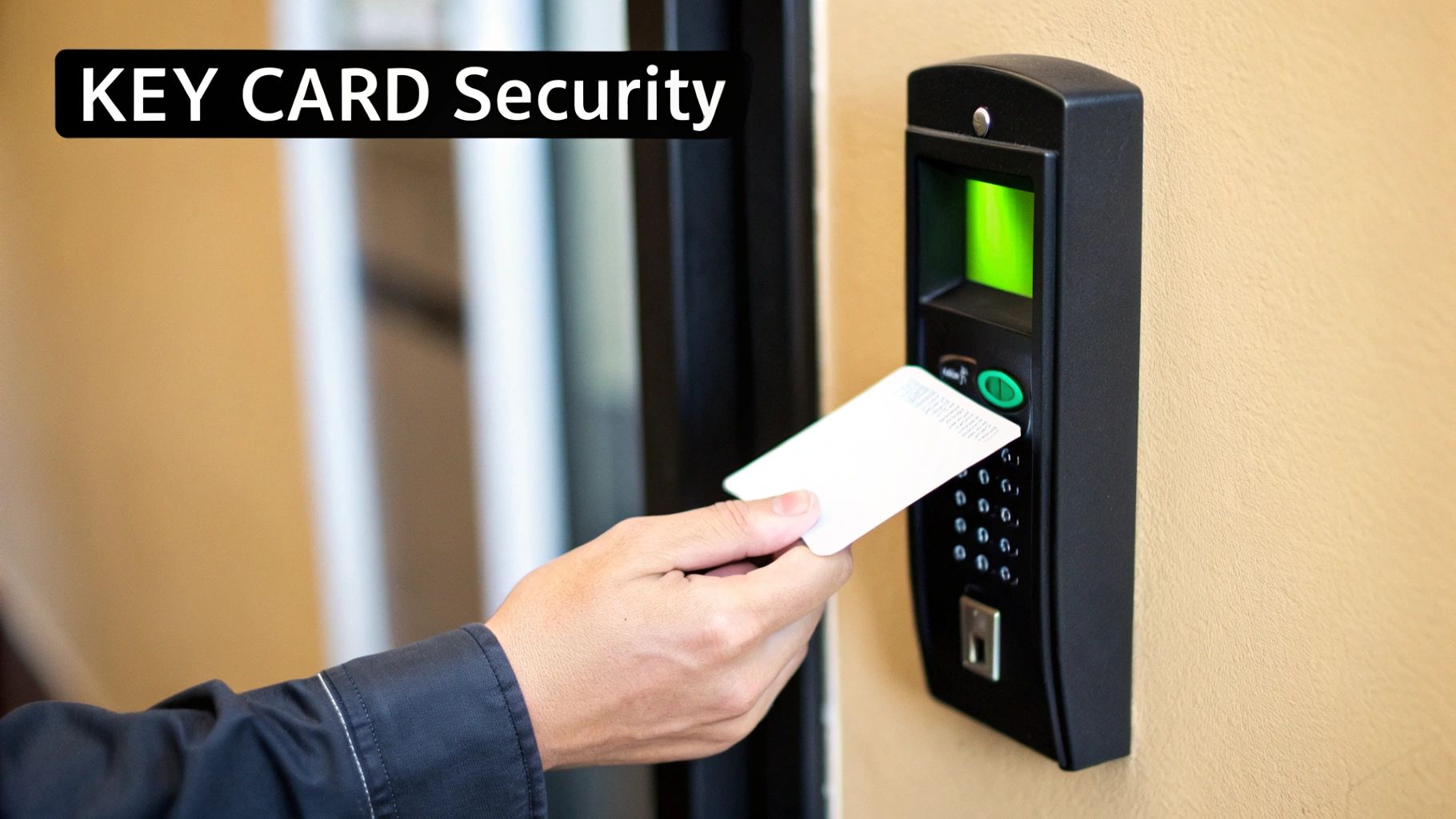
This discipline extends beyond just holding onto your card. It involves a conscious awareness of how you handle your room number, interact with hotel staff, and utilize the physical security features of your door. Failing to manage these access points can create vulnerabilities that criminals are adept at exploiting.
How to Maintain Control Over Your Room Access
Effective access management combines discretion with consistent security protocols. Your goal is to make your room a hard target by controlling information and using all available physical barriers.
- Handle Your Key Card Securely: Treat your key card like a credit card. Never leave it lying on a restaurant table or pool chair. Keep it in a secure pocket, wallet, or purse. Consider using an RFID-blocking wallet or sleeve to prevent criminals from electronically skimming your card’s data.
- Guard Your Room Number: When you check in, if the clerk says your room number aloud, politely ask for a different room and for the new number to be written down. Never say your room number aloud in public areas like the lobby or elevator.
- Verify All Unsolicited Visitors: If someone claiming to be hotel staff knocks on your door for an unexpected service, do not open it. Always call the front desk using the room phone to verify their identity and purpose before granting access. Use the door’s peephole first.
Key Insight: The most secure door in the world is useless if you open it to the wrong person. Social engineering, where a person manipulates you into granting access, is a common tactic. Always verify before you open.
Immediately report a lost or stolen key card to the front desk so they can deactivate it and issue a new one. This simple, swift action is one of the most effective hotel safety tips for ensuring no one else can use your lost card to enter your room.
6. Maintain Situational Awareness and Trust Your Instincts
Beyond physical locks and security gadgets, one of the most powerful hotel safety tips relies on your own perception and intuition. Developing and maintaining situational awareness means being actively conscious of your environment and the people in it, allowing you to identify and react to potential threats before they escalate. It’s a mindset, not a device.
This skill, often championed by personal safety experts and law enforcement, involves consciously observing, orienting, and deciding on a course of action. It’s about switching from a passive, relaxed state to an alert, engaged one, especially during transitional moments like entering the hotel, walking through corridors, or using the elevator.
How to Practice Active Awareness
Putting situational awareness into practice means engaging your senses and actively processing the information they provide. It’s a continuous loop of observation and assessment that becomes second nature with practice.
- Observe Your Surroundings: When you walk through the lobby or down a hallway, make a mental note of who is around you. Notice if someone seems to be loitering without purpose or paying undue attention to you or other guests. Identify the locations of security cameras, staff members, and, most importantly, emergency exits.
- Trust Your Gut Feeling: Your intuition is a powerful subconscious pattern-recognition tool. If a person, a situation, or a location feels “off” or unsafe, do not dismiss it. That feeling is your brain signaling a potential risk. Trust it and remove yourself from the situation, whether that means taking the next elevator or returning to the well-lit lobby.
- Control Your Digital Distractions: One of the biggest hindrances to awareness is your smartphone. Walking through a hotel while texting, scrolling, or wearing noise-canceling headphones makes you an easy target. Keep your head up and your phone away when moving through public or semi-private spaces like hallways.
Key Insight: Situational awareness isn’t about paranoia; it’s about presence. Being present and observant allows you to project confidence and makes you a less appealing target for those with malicious intent.
7. Know Emergency Procedures and Evacuation Routes
While we hope to never use them, understanding a hotel’s emergency protocols and your specific evacuation path is a non-negotiable part of responsible travel. In the event of a fire, natural disaster, or security threat, a few minutes of preparation upon arrival can make a critical difference. This preparation transforms you from a panicked guest into a person with a clear, actionable plan.
Familiarizing yourself with these procedures isn’t about expecting the worst; it’s about being equipped to handle it. This knowledge empowers you to navigate a high-stress situation calmly and efficiently, ensuring your safety and the safety of those around you.
How to Prepare for an Emergency
Your first 15 minutes in the room are the perfect time to build your emergency plan. This simple habit should be as routine as unpacking your toiletries, providing you with essential hotel safety tips for any unforeseen event.
- Study the Evacuation Map: The first thing you should do is locate the emergency map, usually found on the back of your hotel room door. Don’t just glance at it; identify the primary and secondary exit routes from your room.
- Walk the Route: Physically walk the path from your door to the nearest emergency exit. Note any turns or obstacles. Then, do the same for the secondary route. This muscle memory is invaluable in a dark or smoke-filled hallway.
- Count the Doors: As you walk the evacuation route, count the number of doors between your room and the exit. In a low-visibility situation, you can feel your way along the wall and count the doors to find the exit stairwell.
- Locate Safety Equipment: During your walk, identify the location of fire extinguishers, fire alarms, and any emergency phones on your floor. Knowing their exact location saves precious seconds.
- Prepare Your “Go” Items: Keep your room key, phone, a flashlight, and shoes right next to your bed. In an emergency, you won’t have time to search for these essentials.
Key Insight: Many hotels in regions prone to specific natural disasters, like earthquakes or hurricanes, have unique procedures. Check the guest services book or ask the front desk about specific protocols beyond fire evacuation.
This immediate familiarization is one of the most effective hotel safety tips because it prepares you to act decisively when others might freeze. It’s a small investment of time that offers an immeasurable return in a crisis.
7 Key Hotel Safety Tips Comparison
| Safety Strategy | Implementation Complexity 🔄 | Resource Requirements ⚡ | Expected Outcomes 📊 | Ideal Use Cases 💡 | Key Advantages ⭐ |
|---|---|---|---|---|---|
| Research Your Hotel and Area Before Arrival | Moderate 🔄🔄 | Low (Internet access, time) ⚡ | Informed booking and risk mitigation 📊 | Planning trips to unfamiliar or risky areas 💡 | Prevents unsafe bookings; risk identification ⭐⭐ |
| Choose Your Room Location Strategically | Low to Moderate 🔄 | Low (communication with hotel staff) ⚡ | Enhanced safety and emergency access 📊 | Checking in at hotels in urban or high-risk locations 💡 | Improved evacuation and security access ⭐⭐ |
| Inspect Your Room Thoroughly Upon Arrival | Moderate to High 🔄🔄🔄 | Low (time, awareness) ⚡ | Immediate vulnerability detection 📊 | Newly arrived guests wanting to ensure safety 💡 | Identifies hazards and ensures equipment function ⭐⭐⭐ |
| Secure Your Valuables and Personal Information | Moderate 🔄🔄 | Moderate (safes, RFID-blocking tools) ⚡ | Reduced theft and identity protection 📊 | Travelers with valuables or sensitive info 💡 | Protects assets and reduces theft risk ⭐⭐ |
| Practice Smart Key Card and Access Management | Moderate 🔄🔄 | Low (vigilance, RFID holders) ⚡ | Prevention of unauthorized access 📊 | Frequent hotel guests or those in high-crime areas 💡 | Safeguards privacy; counters social engineering ⭐⭐ |
| Maintain Situational Awareness and Trust Your Instincts | High 🔄🔄🔄 | Low (mental focus, alertness) ⚡ | Early threat detection and safety boost 📊 | All travelers, especially solo or vulnerable persons 💡 | Improved decision-making and confidence ⭐⭐⭐ |
| Know Emergency Procedures and Evacuation Routes | Low to Moderate 🔄🔄 | Low (time, attention) ⚡ | Effective emergency response 📊 | All hotel stays, especially in disaster-prone areas 💡 | Increases survival chances and reduces panic ⭐⭐⭐ |
Travel Confidently with Smart Safety Practices
Navigating the world of travel should be an experience filled with excitement and discovery, not apprehension. By integrating the comprehensive hotel safety tips detailed throughout this guide, you fundamentally shift your role from a passive guest to an empowered and proactive traveler. The strategies we’ve covered are not designed to induce fear but to build a strong foundation of security and preparedness, allowing you to immerse yourself fully in your destination with peace of mind.
True travel confidence stems from knowing you have taken deliberate, intelligent steps to protect yourself and your belongings. This proactive mindset is the most valuable tool you can carry on any journey. It’s about making safety an active process, a series of conscious choices rather than a passive hope that everything will be fine.
From Theory to Habit: Your Action Plan
Let’s distill the core principles from this article into a simple, repeatable framework. Mastering these concepts transforms them from a checklist into second-nature habits for every trip you take.
- Preparation is Paramount: Your safety efforts begin long before you step into a hotel lobby. Diligent research into your hotel’s reputation and the surrounding area’s safety profile, as discussed in our first point, sets the stage for a secure stay. Choosing a room away from the ground floor and high-traffic areas further solidifies this preparatory defense.
- Vigilance is Your Best Defense: Upon arrival, your most critical tasks are inspection and awareness. A thorough room check for signs of tampering, hidden devices, or malfunctioning locks is non-negotiable. This vigilance extends to how you manage your key card, secure valuables in the safe, and maintain constant situational awareness in public spaces like lobbies, elevators, and hallways. Always trust your instincts; they are your most reliable internal security system.
- Preparedness Creates Calm: Knowing the hotel’s emergency procedures and identifying multiple evacuation routes isn’t about expecting the worst. It’s about being equipped to handle unforeseen events calmly and efficiently. This knowledge replaces panic with a clear plan of action, ensuring you can react effectively in a high-stress situation.
Ultimately, these hotel safety tips are about control. You control the information you gather, the room you select, the security of your immediate environment, and your level of awareness. By taking ownership of these elements, you significantly reduce your vulnerability to common travel risks, from petty theft to more serious threats.
Making these practices a consistent part of your travel routine ensures that every journey is not just memorable and enriching, but also fundamentally secure. The goal is to make safety so ingrained in your travel habits that it becomes automatic, freeing your mind to focus on the joy and adventure that awaits. Travel smart, stay safe, and unlock the full potential of every destination you explore.
Ready to find a hotel that meets your safety and comfort standards? Use HotelsEscape to access detailed guest reviews, neighborhood safety insights, and filter options that help you choose the perfect, secure accommodation for your next trip. Visit HotelsEscape to book with confidence and travel with peace of mind.
